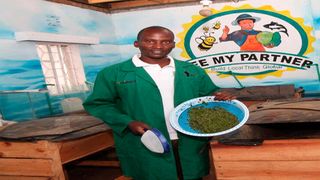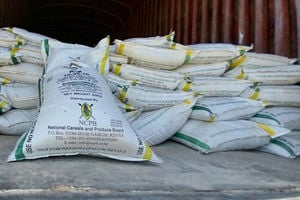
Robert Mwangi next to an aquarium on February 15. He is a chicken and catfish farmer.
| Richard Maosi | Nation Media GroupSeeds of Gold
Premium
Azola comes to rescue of Njoro farmer
What you need to know:
- Mwangi began with Sh32,000 which went into building a simple coop and buying 120 chicks and feeds.
- Farmer attended an exhibition at Egerton University in 2020 where he was introduced to azolla fodder.
Eleven kilometres from Egerton University on the Njoro-Mau Narok road is Sinendet village. Huge tracts of land lie bare. Many families prefer subsistence farming, supplemented by kitchen gardening.
Insufficient rains have led to a fall in yields of staples like maize and beans in the recent past. It is here that we meet Robert Mwangi harvesting azolla plant from one of his six fish ponds.
Mwangi is the chairman of a 13-member Bee My Partner Youth Group, six of whom are females.
“Azolla plant is ideal and a sustainable feed for cattle, fish, pigs and poultry. It is also a rich source of organic fertiliser,” Mwangi says.
His two-acre land has goats, sukuma wiki and 100 chickens. It also has a greenhouse with 20 netable tanks, each with a capacity of 2,000 litres.
The tanks have catfish at various stages of development.
“I decided to rear the catfish as they are hardy and survive in tough conditions. Tilapia requires a regular supply of fresh water,” says the Economics and Statistics graduate.
After completing his undergraduate studies in 2015, Mwangi worked at an auditing firm in Nairobi before shifting to Makueni and Kajiado as a supplier at a fertiliser company.
Alternative feed
Back home, he had five langstroth beehives under the care of his mother. One day, Mwangi went home and harvested all the honey.
He got 66 kilos and sold each for Sh600. The amount he made on that day alone was more than his monthly salary.
He resigned in 2018 and went back home to start poultry farming. Mwangi began with Sh32,000 which went into building a simple coop and buying 120 chicks and feeds.
Due to the high cost of bringing the feeds home, he obtained formulated ones.
Unfortunately, Mwangi incurred a heavier cost, reducing his monthly profit to just Sh2,000.
Mwangi attended an exhibition at Egerton University in 2020 where he was introduced to azolla fodder.
The farmer learnt that azolla could be an alternative feed for his birds, whose population had fallen to 75.
“I bought a kilo of azolla seeds for Sh1,000,” he says.
Bees population
All Mwangi needed was shade. He sought a place at his family farm with trees and set up two ponds, each measuring 10 to 12 centimetres deep and a length of 1.5 by three metres. He dug four other ponds, each measuring three by 2.5 metres .
It takes two weeks for the feeds to attain maturity. He used fresh cow dung to “fertilise” the water. Mwangi mixed it well to make it slurry before introducing the seeds.
Taking care of the plant is easy. When azolla begins to redden, it means there are no nutrients in water. Watering ends there.
The azolla plant has helped maintain the population of his bees during drought. The insects fly and form good landing ground on a floating water fern.
Once harvested, the azolla is fed to the chickens and goats. He sells the surplus to local farmers as seed or produce. A kilogramme goes for Sh1,000.
Mwangi has hired two young men. He harvests between 16 to 18 kilos of the azolla protein plant. It is complemented with other feeds like crushed maize cob, chick mash and fish meal.
Mwangi says the project has reduced dependence on formulated feeds by 25 per cent.
He can now save up to Sh40,000 in a month. The farmer says azolla is highly nutritious as it improves the quality of meat in chickens and provides a stable egg production.
Excellent supplement
Mwangi sees himself in a position to assist farmers reduce the cost of animal and plant production five years from now.
The major challenge he faces is inconsistent water supply. Sinendet receives little annual rain, making Mwangi buy water especially during the December-March dry spell.
Dennis Ngelyo, an expert in Animal Science, says azolla is an excellent supplement for livestock, fish and poultry feeds.
“It drastically cuts the cost of feeds, especially among dairy farmers. At the same time, azolla increases milk yields,” Ngelyo says.
The experts adds that azolla has many nutrients compared to traditional fodder.
“It is very rich in proteins, amino acids, vitamins, calcium and phosphorus,” he says.
He adds that the plant is easy to grow as the farmer only requires water, planting material and manure.
“It can thrive in any environment. Farmers plant it in ditches, ponds and even a controlled environment like greenhouses,” he says.





